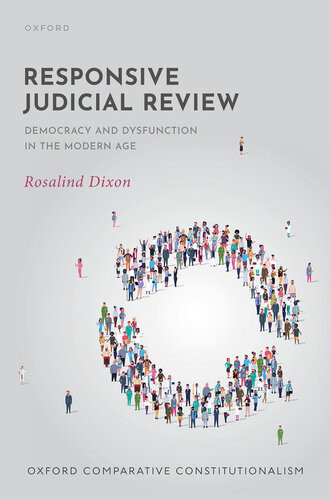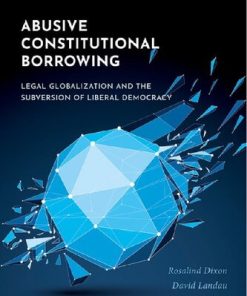Responsive Judicial Review Rosalind Dixon
$50.00 Original price was: $50.00.$25.00Current price is: $25.00.
Responsive Judicial Review Rosalind Dixon – Ebook Instant Download/Delivery ISBN(s): 9780192865779,0192865773,9780192689719,0192689711

Product details:
- ISBN 10: 0192689711
- ISBN 13: 9780192689719
- Author: Rosalind Dixon
Democratic dysfunction can arise in both ‘at risk’ and well-functioning constitutional systems. It can threaten a system’s responsiveness to both minority rights claims and majoritarian constitutional understandings. Responsive Judicial Review aims to counter this dysfunction using examples from both the global north and global south, including leading constitutional courts in the US, UK, Canada, India, South Africa, and Colombia, as well as select aspects of the constitutional jurisprudence of courts in Australia, Fiji, Hong Kong, and Korea.
In this book, Dixon argues that courts should adopt a sufficiently ‘dialogic’ approach to countering relevant democratic blockages and look for ways to increase the actual and perceived legitimacy of their decisions―through careful choices about their framing, and the timing and selection of cases. By orienting judicial choices about constitutional construction toward promoting democratic responsiveness, or toward countering forms of democratic monopoly, blind spots, and burdens of inertia, judicial review helps safeguard a constitutional system’s responsiveness to democratic majority understandings. The idea of ‘responsive’ judicial review encourages courts to engage with their own distinct institutional position, and potential limits on their own capacity and legitimacy.
Table contents:
1. Introduction
Part 1 Democratic Foundations
2. Constitutions and Constructional Choice
A. Judicial Review and Constructional Choice
1. Abortion, sexual privacy, and same-sex marriage
2. Implied speech and equality rights
3. Structural social rights
4. An unconstitutional amendment doctrine
B. Constitutional Theory and Constructional Choice
1. Abortion
2. Sexual privacy and equality
3. Structural social rights
C. Why Courts? Constitutional Choice and Democracy
D. Ely’s Response
E. Criticism of Ely’s Approach
F. Representation-Reinforcement Beyond Ely
3. Defining Democracy and Democratic Dysfunction
A. Defining Democracy
B. Democratic Dysfunction: Antidemocratic Monopoly Power
1. Electoral monopoly
2. Institutional monopoly
3. Monopoly: Intent versus effect
C. Legislative Blind Spots and Burdens of Inertia
1. Legislative blind spots
2. Legislative burdens of inertia
D. “Deliberate” versus Interconnected Democratic Blockages
Part 2 Courts and Democratic Responsiveness
4. The Scope and Intensity of Responsive Judicial Review
A. The Legal and Political Legitimacy of Judicial Review
B. The Political Legitimacy of Constitutional Implications
C. Responsive Review in Practice
1. Abortion rights
2. LGBTQI+ rights
3. Implied rights to freedom of expression and equality
4. Structural social rights
5. Unconstitutional amendment doctrine
D. The Intensity of Judicial Review: Toward Calibrated Proportionality or Scrutiny
1. Calibrating judgments about limitations on expression
2. Calibrating judgments about discrimination
E. Deference and a Legislative Action/Inaction Distinction
5. Democratic Dysfunction and the Effectiveness of Responsive Review
A. Detecting Democratic Dysfunction
B. Countering Dysfunction
C. Responsive Judicial Review in Practice
1. Comparative LGBTQI + rights
2. Structural social rights
3. Unconstitutional amendment doctrine
D. Preconditions for Success
1. Judicial independence and a political tolerance interval for judicial review
2. Litigation support structure
3. Jurisdiction and remedial toolkit
6. Risks to Democracy: Reverse Inertia, Democratic Backlash, and Debilitation
A. Limits on Judicial Capacity and Legitimacy
B. Reverse Burdens of Inertia
C. Democratic Backlash
D. Democratic Debilitation
E. Judicial Prudence, Principle, and Pragmatism
7. Toward Strong–Weak/Weak–Strong Judicial Review and Remedies
A. Weakened Judicial Review
B. Why (and How to) Weaken Review
1. The democratic minimum core and the pragmatic argument for weak–strong judicial review
2. Blind spots and burdens of inertia: a principled and pragmatic case for weak–strong review
C. Toward Strong–Weak/Weak–Strong Judicial Review
D. Conclusion
Part 3 Responsive Judging and Comparative Constitutional Theory
8. A Responsive Judicial Voice: Building a Court’s Legitimacy
A. Why Responsive Judging—or a Responsive Judicial Voice
B. Judicial Framing and Responsive Judicial Review
1. Authorship
2. Tone: Respect or comity
3. Narrative
C. Responsive Judicial Review and Judging: Building Support for LGBTQI+ Rights
D. Responsive Judging and the Democratic Minimum Core
E. Responsive Judging: Limits and Cautions
1. Limits on responsive judging
2. Democratic legitimacy versus legitimation
3. A responsive judicial voice beyond the bench
9. Conclusion: Toward a New Comparative Political Process Theory?
People also search:
what is judicial review example
a judicial review
judicial review answers
a responsibility of the judicial branch
what is a judicial review quizlet
You may also like…
Uncategorized
Home, School, and Community Collaboration: Culturally Responsive Family Engagement (NULL)
Uncategorized
Romance - Erotic Romance
Romance - Science Fiction Romance
Jurisprudence & Law - General & Miscellaneous Law
Politics & Philosophy - Social Sciences
Education Studies & Teaching - Bilingual & Multicultural Education
Uncategorized
(Ebook PDF) Smart Stimuli Responsive Polymers 1st edition by Liang Hu 9783527832385 full chapters












